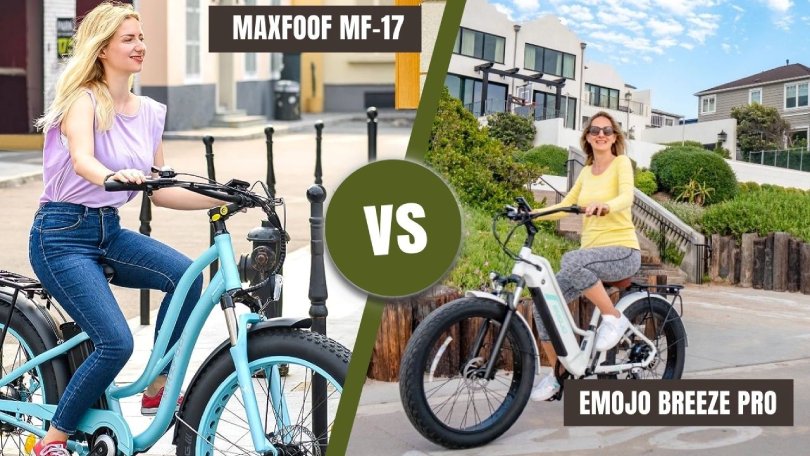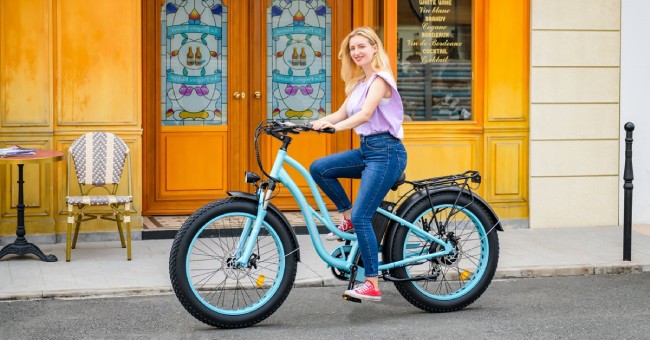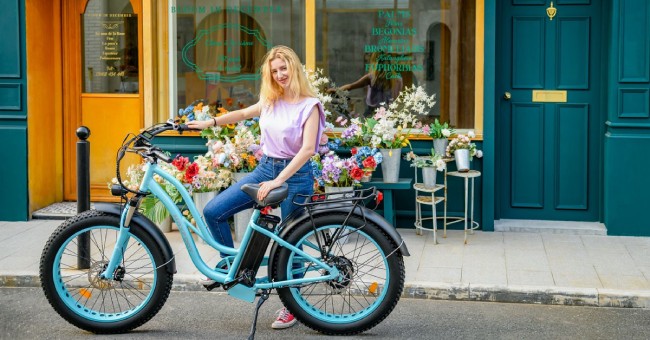Electric cruiser bikes offer a blend of style and functionality that’s hard to resist. Among the top contenders in this category are the Maxfoot MF-17 and the Emojo Breeze Pro.
Both bikes boast impressive features and have garnered attention from enthusiasts and casual riders alike. But how do they stack up against each other? Let’s find out.
Maxfoot MF-17 vs Emojo Breeze Pro: A Quick Comparison
The Maxfoot MF-17 is a robust fat tire cruiser bike, equipped with a potent 750W motor. Capable of reaching speeds up to 23 mph and backed by a battery that assists for an impressive 55 miles, it’s an exceptional choice for daily commutes.
In contrast, the Emojo Breeze Pro showcases design finesse and functionality. This elegantly crafted step-through cruiser seamlessly integrates its battery, offering both 500W and 750W power variants. With the potential to hit speeds of up to 20 mph, it is where style meets performance.
Before we get into details; here’s a summarized comparison of both bikes:
| Features | Maxfoot MF-17 | Emojo Breeze Pro |
| Price | $1395 | $2,399 |
| Motor Power | 750W | 500/750W |
| Battery | 48V 13 Ah | 48V 13Ah |
| Charging Time | 4 – 5 hrs | 4 – 6 hrs |
| Maximum Range | 45-55 miles with PAS 1 | 30 miles |
| Top Speed | 23 mph | 20 mph |
| Suspension | Front Suspension Fork | Rigid Fork |
| Tires | (26″ x 4 ″) | (26″ x 4 ″) |
| Net Weight | 70 lbs. | 83 lbs. |
| Max. Supported Weight | 300 lbs. | 250 lbs. |
| Warranty | 12 Months +
24 Months of Technical Support |
12 Months |
| Free Add-Ons | Side mirrors
Rear Storage Rack Mobile Phone holder |
— |
Design
Both e-bikes, the Maxfoot MF-17 and the Emojo Breeze Pro boast an easy-to-mount step-through frame. This makes them accessible to riders of all ages and sizes. However, their designs diverge in terms of aesthetics and structure.
The Breeze Pro offers a more linear and streamlined look, with its battery seamlessly integrated into the frame, serving as a cross-member. This integration not only enhances the bike’s visual appeal but also contributes to its structural integrity.
In contrast, the MF-17 sports stylish curves that lend it a contemporary and fresh appearance. Its battery placement beneath the seat not only complements its modern design but also ensures a lower center of gravity, providing the bike with enhanced stability.
Weight-wise, there is a noticeable difference between the two. The Maxfoot MF-17 weighs in at 70 lbs., making it relatively lighter and potentially easier to maneuver. On the other hand, the Emojo Breeze Pro is a bit heftier at 83 lbs., which might offer a sturdier feel during rides.
Power
In the power segment, the Maxfoot MF-17 doesn’t hold back. Equipped with a 750W motor that can surge up to a peak power of 1050W, it promises a thrilling ride. This power allows riders to reach a commendable top speed of 23 mph. So, its commutes are not only efficient but also exhilarating.
On the other side of the spectrum, the Emojo Breeze Pro offers versatility with its two motor options: 500W and 750W. While the 500W variant is ideal for those seeking a more relaxed and casual ride, the 750W version matches the MF-17’s power, capping at a top speed of 20 mph.
However, it’s worth noting that the high-end variant of the Breeze Pro comes at a premium, costing almost double that of the MF-17. Consider that before upgrading.
Battery and Range
In the case of the battery, the Maxfoot MF-17 and the Emojo Breeze Pro seem evenly matched on paper, each boasting a 48V 13.5 Ah battery. However, as with many e-bikes, the devil is in the details, and it’s the range that often sets them apart.
The Maxfoot MF-17 impressively capitalizes on its battery capacity, offering a range of 45-55 miles when using PAS 1. This extended range lets riders embark on longer journeys without the constant worry of battery depletion.
In comparison, the Emojo Breeze Pro provides a range of up to 30 miles. Although this is certainly respectable and sufficient for many urban commutes, it falls short when juxtaposed with the MF-17’s range.
Ride Comfort
Ride comfort is a function of the vehicle’s suspension and tires. For the Maxfoot MF-17 and the Emojo Breeze Pro, comfort is evidently a top priority, as reflected in their design, tires, and suspension.
As mentioned earlier, the structural design of both bikes is quite similar, which plays a pivotal role in ensuring a comfortable ride. Further enhancing the comfort quotient are the 4-inch wide fat tires present on both models. These tires not only provide excellent traction on a variety of terrains but also act as natural shock absorbers.
The icing on the cake, however, is the front hydraulic suspension that both e-bikes are equipped with. This suspension system easily resists those bumps and potholes and makes your ride smooth.
Add-Ons
Sometimes little extras can make all the difference. That’s the case here. The Emojo Breeze Pro takes pride in its bold LCD, which serves as a clear and comprehensive dashboard for riders. This display provides all the essential information at a glance, from speed and battery status to charging indicators.
The MF-17 also boasts an LCD, but it’s a tad smaller in comparison. However, it makes up for it with an added feature: a USB port. This addition allows riders to charge their devices on the move.
MF-17 doesn’t stop there. For those who appreciate getting a little extra with their purchase, Maxfoot offers a trio of free complimentary add-ons. Riders are treated to a side mirror for enhanced road safety, a storage box for those essential items, and a mobile phone holder to keep their device secure and accessible during rides.
Maxfoot MF-17 vs Emojo Breeze Pro: Which one provides true value for money?
Price-wise, the Emojo Breeze Pro comes in at a steeper $2,399, which, given its features, seems a bit on the higher side. On the other hand, the Maxfoot MF-17, priced at a more accessible $1,395, offers a competitive set of features, some of which even surpass those of the Breeze Pro.
Considering the close feature parity between the two e-bikes and the significant price difference, the Maxfoot MF-17 emerges as a more cost-effective option. It delivers a robust performance, a range of add-ons, and a modern design, all at a price point that’s considerably more wallet-friendly.










